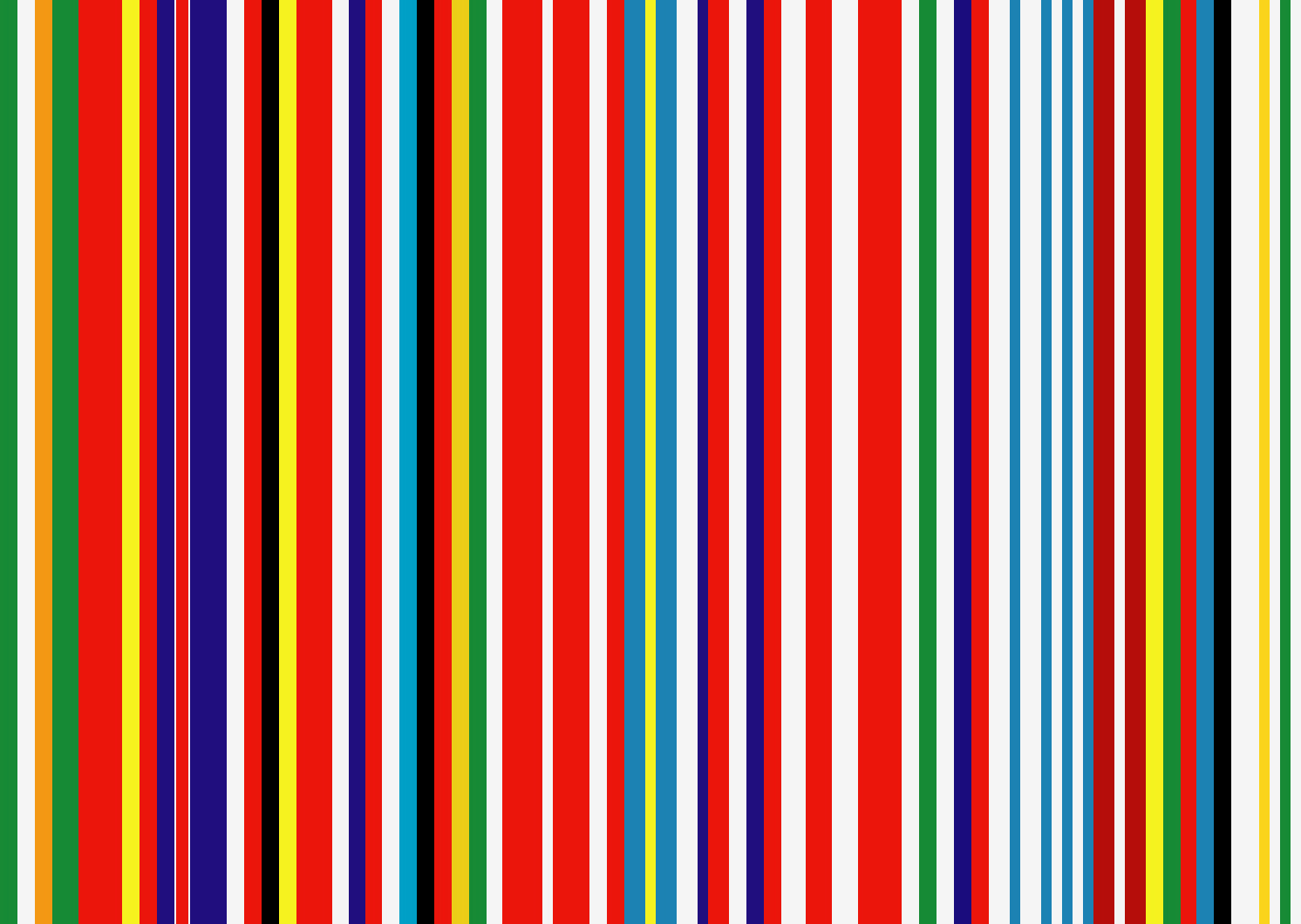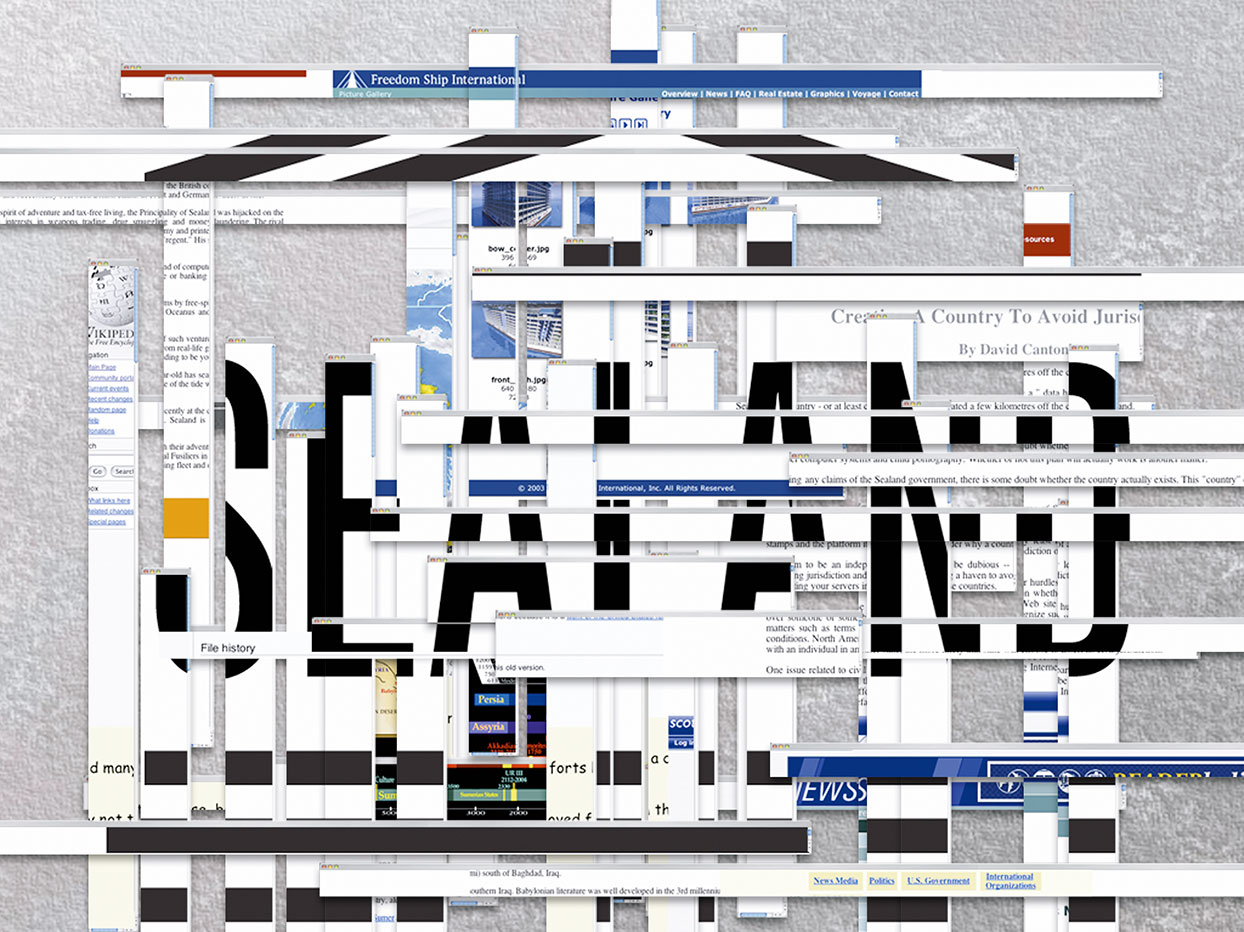Empire and Design
April 13, 2005essay,
When the political discourse retreates to the realm of the visual, when we are supposed to debate the appearance of a flag, then we have to admit that politics has become little more than visual design, according to the Belgian philosopher Dieter Lesage. He argues for a ‘fundamentalism of human rights’ that will guide us out of the post-political impasse of Empire, the world-embracing network characterized by Negri and Hardt.1

Several years ago, Antonio Negri and Michael Hardt gave a powerful new twist to the globalization debate by introducing the concept of Empire.2 By this they meant a new kind of sovereignty that is postmodern, post-imperialist and post-colonial alike. They contended that sovereignty was no longer the prerogative of nation-states but was increasingly characterizing a global network of organizations and institutions whose rule over the whole world territory was underpinned by a global consensus on human rights.
This Imperial network, according to Negri and Hardt, has a pyramidal structure with three tiers: in the role of the monarchy we find the United States, the g7 countries, the World Bank, the World Trade Organization and nato; the other nation states and the transnational corporations form a worldwide aristocracy; and the media, religious institutions, the United Nations and ngos democratically attempt to represent the People. Empire, like the Roman Empire, thus combines the political regimes of monarchy, aristocracy and democracy, as a means to control the inherent power of the global multitude.
Nation-states are embedded within this imperial network, and their role consists of filtering the flows of the multitude, capital and goods and thus determining their respective mobility on the Imperial territory. Sovereignty, that is, the power to declare a state of emergency or, rather, the state of exception, has become the prerogative of Empire. Even the United States must be regarded as part of this Imperial network. us military hegemony naturally gives them a function within the Empire with which scarcely any other nation-state can compete, but they can no longer ‘go it alone’, as Negri and Hardt continue to argue in their latest book, Multitude.3 The fact that the United States does not play its monarchist role properly and does indeed go it alone, even if it is not supposed to, is the biggest problem Empire today faces and one for which it is desperate to find a solution.
Identity and Design
The reduction of the status of nation-states from holders of sovereignty to functional filters within the global imperial framework does not mean that they can no longer be different from one another. There is surely still some space for national identity. But this identity can no longer have a deep political significance, as it used to have during the Cold War. Empire will want all nation-states to be organized as democracies. At least, all nation-states are under the Imperial obligation to commit to the principles enshrined in several universal declarations of human rights. A country can no longer derive its identity from its political principles. If it does, it becomes an exception that Empire must deal with.
If the political identities of nation-states are under the Imperial mandate of sameness, then we are left with their cultural identities as the only terrain for differences and discussion. Negri and Hardt insist that, contrary to the widespread belief in the destructive impact of globalization on cultural differences, Empire encourages the construction of culturally defined national identities. It has no interest in the erasure of all differences. Imperial rule corresponds to a triple imperative: ‘incorporate, differentiate, manage.’4 The first of these is the liberal, inclusive face of Empire, which says ‘all are welcome within its boundaries, regardless of race, creed, colour, gender, sexual orientation and so forth’.5 The second imperative concerns affirmation of those differences that are acceptable within the Imperial realm. ‘While from the juridical perspective differences must be set aside, from the cultural perspective differences are celebrated.’6 As an example, Negri and Hardt refer to the re-creation of ethnic identities in the formerly socialist countries, where local languages, traditional place names, arts and handcrafts are celebrated as components of the transition from socialism to capitalism.7 The third imperative implies managing all these differences in a general economy of control.
It is for all these reasons that discussions on the visual identity of political entities or authorities quickly prove unsatisfactory, however interesting or witty they may be. Empire is represented as a pyramid, an eminent architectural form. But if the architecture of global politics is no longer open to discussion because it is presumed to be the expression of a well-established global consensus, all that is left for us to discuss is the design of global architecture. This is why there seems to be less complaint about the constitutional structure of the European Union and the part it can play within Empire than about the ugliness of the buildings of the European administration in Brussels. If the political discourse retreats to the realm of the visual, if we are supposed to debate the look of a flag, then we must concede to the Imperial mandate that politics is merely a matter of design. This imperative is wholly consistent with Fukuyama’s thesis of the end of history. In the post-historical era of capitalist liberal democracy, not only is art reduced to a formal exercise like ikebana, but there is no longer any space for political acts. In this respect, too, the post-historical age is also a post-political one, an age in which the only remaining area of concern for the politician is territorial identity. Artists, designers and architects are only too glad to lend a helping hand. Even those architects who feel it is their duty to provide trendy logos for ponderous liberal-democratic institutions are actually embracing Fukuyama’s ikebana-philosophy of art, however much they may deny it. Consequently, it is somewhat ironic that in 2003 Rem Koolhaas won the 15th Praemium Imperiale of the Japan Art Association.
Alexandre Kojève, who, after the World War II, gave up his professorate of philosophy in favour of a career in the European Commission, would no doubt have been pleased with Koolhaas’s provocative proposal for a new European emblem: the ‘barcode flag’.8 Koolhaas’s symbol, which solves the problem of representing the muddled, confederate character of the EU by treating it as a branding issue, marks the point when ikebana has at last become the model for artistic practice as Kojève once predicted. The role of the artist, or in this case the architect, entails at most the ‘expression’ and visual styling of politics. For AMO (the research offshoot of OMA), Prodi is no less a client than Prada.
Once the end of history has been reached, art and politics meet to discuss the form of a multicoloured ‘flag’.9 AMO’s barcode Europe tallies with a consumerist conception of politics in which citizens are seen as customers for political products. Koolhaas is convinced the European Union doesn’t sell, good though the product may be. This consumerist approach to politics is dubious enough, quite apart from AMO’s proposal for a new visual style for the European Union. Putting all the colours of the eu nation-states together to make a colourful barcode is not only tantamount to consumerist logic but gives in to precisely the kind of paralysing confederative thinking that prevents the eu from becoming an attractive political force. To begin with, we should start seeing the European Union as something more than an aggregation of nation-states. But AMO shows its inability to do so with its barcode flag proposal.
The Geography of Extraterritoriality
The visual design of territorial identity on the whole tends to legitimize the political structure of Empire; the resulting form defers to the restrictions the imperial regime imposes on the political imagination. The designer does not challenge the constitutional foundations of the territory whose identity he is supposed to define, but to characterize that territory, to give it a name and a face so that it can take its rightful place within the Empire.
Most of the territories the designer is asked to deal with presumably seek a visual identity in order to establish a place for themselves within the global Empire. But what about the ‘islands’ which the German curator and critic Anselm Franke described and listed in Territories: Islands, Camps and Other States of Utopia?10 Franke’s impressive list aspires to offer a ‘geography of the extraterritorial’.11 In an essay on the spatial logic of islands, Franke apparently seeks out zones that shun the omnipresent sovereign authority of Empire. Negri and Hardt deny that Empire has an ‘outside’; in other words, they claim that the imperial territory embraces virtually the whole earth. But couldn’t we argue that the ‘islands’, or at least a few of them, constitute a kind of outside? And assuming we recognize the extra-imperial character of these islands, isn’t the interest some designers take in them evidence of their counter-imperial motives?



An example that springs to mind is the Principality of Sealand, an ‘artificial island’ off the coast of England, actually a World War II fort erected on a sunken barge. In the late 1960s, the abandoned superstructure was occupied by a family who immediately declared independence and constituted a hereditary monarchy. A succession of legal actions led, surprisingly though it may seem, to the de facto legal recognition of the sovereignty of the Principality of Sealand. A group of artists and designers from the Jan van Eyck Academy in Maastricht, the self-styled Sealand Identity Team led by Daniël van der Velden, has looked into this fascinating case.12 You could say that the importance of the Principality of Sealand is precisely that it spurns the dominion of Empire. Most designers see no problem whatsoever in designing identities that satisfy the Imperial demands, although it must be the intention of some designers to support resistance to Empire through their work.
Franke appears to use the term extraterritoriality rather loosely. In international affairs, the term does not relate to territories falling outside all national jurisdiction, but to national legislation incorporating a claim to validity in territories outside national territory. Although some ‘islands’ on Franke’s list may give the impression that extraterritoriality refers to a place not governed by any legislation, it actually concerns a region where certain laws have declared themselves applicable. Extraterritoriality also refers, in international relations, to the ‘immunity from local law enforcement enjoyed by certain aliens. Although physically present upon the territory of a foreign nation, those aliens possessing extraterritoriality are considered by customary international law or treaty to be under the legal jurisdiction of their home country. This immunity from law enforcement is reciprocal between countries and is generally provided for visiting heads of state, those in the diplomatic services of foreign nations and their families, and officials of the United Nations.’13
Four Fundamental Principles
Defined thus, extraterritoriality is something we could describe as a way of dividing up the legal work, in which the laws of a person’s home country apply instead of those of the country where they are at the moment. International law indeed allows entitlements based on different sets of legal principles, according to Alan Hudson.14 Hudson identifies four principles which may well introduce some clarity into discussions about extraterritoriality: the territorial principle on which the modern conception of sovereignty is founded; the nationality principle which on the one hand underpins diplomatic immunity and on the other can legitimate prosecution of a national who has committed a crime (e.g. a sex offence) abroad; the protective principle which underpins the doctrine of preventive military action; and the principle of universality which comes into play when nation-states are compelled to respect human rights by economic or military pressure. All but the first of these can clearly be used to justify the extraterritorial application and imposition of a certain law or regulation. Only a nation-state or a federation of nation-states such as the European Union can, by definition, appeal to the nationality principle. The protective principle is primarily to be applied by nation-states but it could also be used by transnational organizations such as nato. The principle of universality, finally, is the most credible principle to underpin interventions by such transnational organizations as the United Nations and its related bodies.
Franke’s concept of extraterritoriality seems to have a certain heterogeneity, although it refers primarily to the fact that some so-called islands are seen as falling outside the jurisdiction of a certain national state. A number of the islands on his list demonstrate only that the nation-state is incapable of imposing its sway on the island concerned. These islands, such as the enclaves in Johannesburg classified as ‘paranoid islands’, are in other words zones where the national legislation is theoretically in force but is not effectively imposed; they are thus not de jure extraterritorial in Franke’s sense, even if extraterritorial de facto. Other ‘islands’, strangely enough, owe their inclusion on the list to the fact that they do have a certain sovereignty, if in an atypical manner; for example the abortion ship which sails under a Dutch flag, or American warships deployed outside the 12 mile limits of other nations.
The notorious ‘Wall’ on the West Bank was also mentioned in Franke’s geography of the extraterritorial, but this brings us to a separate problem. The Wall creates whole archipelagos of islands, making life extremely difficult for many of the people living nearby; but it could also be said to be an outstanding expression of the modern conception of sovereignty. The Wall anticipates a definitive delimitation of Israeli and Palestinian sovereign territory, like it or not as a political strategy. But even if we disagree about the fact that the Wall deviates from the Green Line, for example, and even if we protest against its exceptional stupidity in the light of the humanitarian consequences, the Wall still does not prove the existence of extraterritorial islands that fall outside every form of national jurisdiction. On the contrary, the Wall prepares various areas for the fact that they will eventually fall under one or the other national jurisdiction. The idea that a territory can only be subject to a single jurisdiction is completely in accordance with the modern view of sovereignty.
The Paradox of the Postmodern Island
Insofar as Franke’s island project attempts to sketch a ‘geography of extraterritoriality’, and given that since Hardt’s and Negri’s Empire the notion of extraterritoriality has been due for a postmodern redefinition, we cannot evade the question of whether or not there are islands that not only fall outside the jurisdiction of the nation-state but also outside the jurisdiction of the new, postmodern sovereignty of Empire. From a postmodern perspective, an island would thus be an area that rejects all Imperial jurisdiction. This confronts us with a huge paradox. If we accept that Empire has no ‘outside’, we concede that its territory extends over the whole earth and even beyond it; but if we define the postmodern conception of an island as an area outside Imperial jurisdiction, we must concede either that an ‘outside’ does in fact exist, consisting of all known zones that are islands in the postmodern sense, or that such islands do not exist because all zones fall under the jurisdiction of Empire. Either the claims made by Negri and Hardt in Empire are faulty, or Franke’s island list is based on fallacy.
The jurisdiction of Empire predominates by definition over every national jurisdiction. The Imperial laws are in principle set down in conventions, protocols, agreements and un Security Council resolutions. Rather than a whole list of areas where neither national nor supranational laws hold, there are areas where the two are in conflict – a conflict that will not necessarily end in factual imposition of the dominant legislation. From a global standpoint, the tendency, backed by Empire, is for supranational or Imperial laws to take precedence over national laws. An excellent example of this is the ‘Kosovo decision’ taken by nato in 1999 to bombard Serbian military, paramilitary and police positions and infrastructures, officially on the grounds of humanitarian concern for the safety of the Kosovo Albanians.
In the Imperial era it is perfectly possible for there to be territorial oddities, special cases, exceptions, distinct identities, etcetera, but there can be no legal extraterritoriality. The Empire cannot acknowledge extraterritorial laws, because its territory comprises all territories. The Empire will ensure that its system of human rights is respected in every corner of the globe, in every nook and cranny. Some islands, such as refugee camps, are a clear example of how Imperial authority can push national authority aside. Islands of that kind are not outside the Empire; on the contrary, nowhere is as ‘inside’ the Empire as these so-called islands.
Anselm Franke’s island list thus forms, on reflection, a proof not so much of the potential or real existence of extraterritoriality, either in the modern or postmodern senses, as of the standpoint that there really is no ‘outside’. The Empire seems to solve all the legal problems created by extraterritorial laws, such as the conflict between two sovereign states that both claim jurisdiction over the same persons or the same events: all persons, all regions and all events now fall under Imperial jurisdiction. Of course, conflicts of jurisdiction clearly occur on a daily basis, so we know we are talking about the concept of Empire, not the reality. Still, faced with the complete legal stalemate of Guantánamo Bay, for example, we may wonder whether there would be some advantage to the Empire really becoming an effective global authority, able to impose its laws by virtue of being more powerful than any of its constituent parts. Would it be so bad if the contract imposed by this global, leviathan-like authority were to consist of the 1948 Universal Declaration of Human Rights?
Bodily Integrity
Against this idea of an Empire capable of imposing adherence to the human rights accord, we might object that nobody ever reads the small print on a contract. People in the present Empire are not so much filled with knowledge and understanding of the letter of the Universal Declaration of Human Rights as with a certain spirit of human rights which, paradoxically, centres on the concept of the body. In his book Iraq. The Borrowed Kettle, Slavoj Žižek notes that ‘what is increasingly emerging as the central “human right” in late capitalist society … [is] the right not to be “harassed”, that is, to be kept at a safe distance from others.’15 It does indeed seem that the present conception of human rights has narrowed down to a respect for bodily integrity. When the International Red Cross insists on checking that the detainees of Guantánamo Bay have not been subjected to torture, it implicitly accepts this limited definition of what human rights are. The western cult of the body has become so dominant that we actually conflate human rights with bodily rights. We have almost reached the point where we seriously believe everything is ok as long as nobody is being tortured. And since we like to believe that all is well in our own house, we naturally wish to demonstrate that torture is something only the other side does.
The spirit of the human rights system, understood as ‘the right not to be harrassed’ is much nicer than its letter. An explanation for this could be that it is literally much cheaper to act according to this factually predominant spirit than it is to act according to the letter of the contract; that it is cheaper to leave people in peace than to support them. This interpretation of human rights allows the Empire to avoid costs it would prefer not to incur. It is clear that this interpretation of human rights as the right ‘not to be harassed’, as the right to be left in peace, is in complete accordance with a neoliberal political outlook. Terrorism may strive for entirely different goals, but in fact it has only contributed to the dominance of this neoliberal interpretation of the nature of human rights. People have the right not to be terrorized, and the Empire therefore has the right to harass anyone suspected of having an aunt whose cousin is in the habit of reading a little bit too (a)loud from the Koran. The annoying and paradoxical side effect of this is that the imperial choice of a very cheap human rights system starts looking like a very expensive one. Perhaps this arouses hope for a Project for a New Global Century instead of the Project for a New American Century. In the long run it could turn out to be more economical to opt for global jurisdiction and justice. The day may come when a neoliberal replies to an antiglobalist’s claim that a different world is possible by saying ‘you’re completely right: it would be cheaper!’
Human Rights Fundamentalism

What form ought resistance take nowadays? Should we admire the model of withdrawing into a zone over which we claim total sovereignty, as exemplified by the Principality of Sealand? This is certainly the utopia of the ‘sovereignists’ within the anti-globalist movement such as Jean-Pierre Chevènement, a former French Minister of the Interior. Setting great store as they do by their territorial identity, the sovereignists are the ultimate adherents of ‘interior design’. Hence the French interpretation of the term ‘state of emergency’, sans aucun doute méthodique possible, comes down to l’exception française. Strongly though France may object to American exceptionalism in geopolitical affairs, the country clamps just as fiercely to an exceptionalist doctrine in cultural matters. Insofar as this policy of cultural identity dominates the logic of sovereignist exceptionalism, it reformulates national sovereignty as autonomy in cultural matters. Insofar as sovereignism is identical to cultural exceptionalism, it falls nicely in line with the logic of Empire.
Empire is better than the nation-state in the same way as capitalism was, for Marx, better than feudalism. Therefore a political project should not consist of marking the identity of a territory within the Imperial territory. We ought not to cooperate with making areas into recognizable, identifiable, branded nation-states by means of postage stamps, coins, flags and all that old-fashioned paraphernalia. If we do, we succumb to the false belief that we live in a post-political era. The discourse on the end of all ideologies is the most ideological discourse of all. We should therefore concern ourselves directly with the ideology of Empire, the ideology that operates on a limited conception of human rights as being merely the right not to be harassed. One way of criticizing this ideology would be not to dispense with human rights altogether, but to become fundamentalists of human rights and hold to the letter of the 1948 Universal Declaration of Human Rights. A strategy of human rights fundamentalism has the advantage that we have a contract undersigned by all parties and we can insist on them sticking to it.
In their critique of Imperial ideology and their enthusiasm for the revolutionary potential of the multitude, Negri and Hardt take no account of the hypothesis that there might already exist a political reflection of the multitude’s longing for peace, namely, the 1948 Universal Declaration of Human Rights. Most of the desires they ascribe to the multitude (the desire for mobility, the desire for a decent standard of living, the desire to be creative) are already enshrined in the Declaration. Article 13, for example, states that ‘Everyone has the right to leave any country, including his own …’ If the longings of the multitude are enshrined as rights in the Universal Declaration of Human Rights, then it is the Empire’s constitutional duty to create the conditions under which the multitude’s longings can be fulfilled. Should the multitude try to overthrow Empire, as Negri and Hardt propose, or would the multitude be wiser to insist that Empire becomes what it now only pretends to be, given its impotence in the face of American exceptionalism?
1. Some of the ideas in this essay were first presented in a lecture given at the conference State of Emergency. Territorial Identity in the Post-political Age, organized by the Jan Van Eyck Academie at Stedelijk Museum CS, Amsterdam, 23 September 2004.
2. See Michael Hardt & Antonio Negri, Empire, Cambridge Massachusetts, Harvard University Press, 2000. For a critique of Empire, see Dieter Lesage, Vertoog over verzet. Politiek in tijden van globalisering, Meulenhoff / Manteau, Amsterdam / Antwerpen 2004.
3. See Michael Hardt & Antonio Negri, Multitude. War and Democracy in the Age of Empire, The Penguin Press, New York 2004.
4. Michael Hardt & Antonio Negri, Empire, op. cit., p. 201.
5. Ibid., p. 198.
6. Ibid., p. 199.
7. Ibid., p. 199.
8. See e.g. The New York Times, 23 May 2002.
9. See also Dieter Lesage, ‘Art after the end of history’, in New commitment. In architecture, art and design, NAi Publishers, Rotterdam 2003, pp. 80–91.
10. See Anselm Franke, Eyal Weizman, Ines Geisler, ‘Eilanden. De geografie van het buitenterritoriale’, Archis, 2003, no. 6, pp. 18–52.
11. See Territories. Islands, Camps and Other States of Utopia, Verlag der Buchhandlung König, Berlin 2003.
12. See Daniël Van der Velden, ‘Mission: impossible. Data Haven, Meta Haven – Sealand Identity Project’, Archis, 2003, no 6, pp. 54–59.
13. See, ‘Extra-territoriality’, Columbia Encyclopedia, 6th Edition, 2001.
14. See Alan Hudson, ‘Beyond the Borders: Globalisation, Sovereignty and Extra-Territoriality’, Geopolitics, (3) 1998, no. 1, pp. 89–105.
15. Slavoj Žižek, Iraq: The Borrowed Kettle, Verso, London / New York 2004, p. 152 (italics by author).
Dieter Lesage (Belgium) is a philosopher and lecturer at the Department of Audiovisual and Performing Arts (RITS) of the Erasmushogeschool in Brussels. His most recent book is Vertoog over verzet. Politiek in tijden van globalisering [Discourse on Resistance. Politics in Times of Globalisation] (Amsterdam-Antwerp: Meulenhoff-Manteau, 2004).